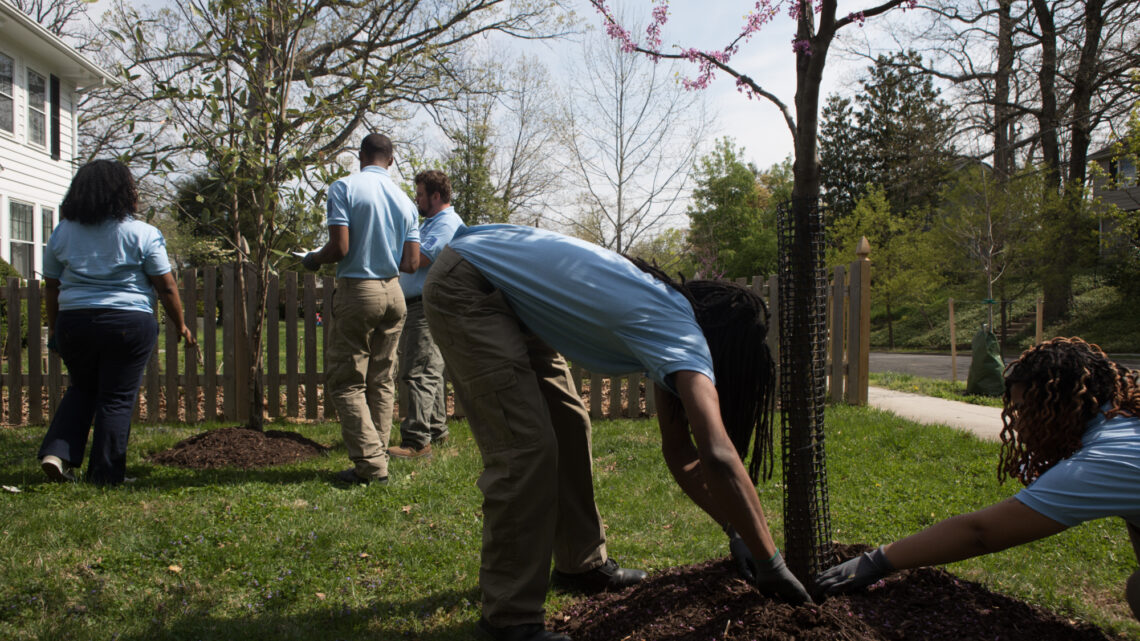Community Trees

Trees are important for a healthy environment. Trees help improve water quality, clean the air, and create habitat. Think of “community trees” as those living close to people. Community trees can be planted in yards, the town park, on schoolyards or along a roadway. These trees can offer additional benefits of increasing property value, providing shade, lowering building energy use, and improving human health.
Trees within the Chesapeake Bay watershed are threatened by increasing development. Seventy acres of forested land is lost each day within the watershed. Tree Canopy is a vital habitat goal for the Chesapeake Bay Watershed Agreement. Stakeholders from across the region are working together to plant 2,400 acres of trees by 2025 within communities of all sizes. Learn more about the benefits of trees in this video from the Chesapeake Bay Program.
Connecting to Issue Investigation
Investigations exploring local environmental conditions and human health can lead towards community trees as a solution. Trees can be planted and/or protected within the community in response to investigations that looked into rising temperatures from climate change, water quality, air pollution, available habitat, or mental and physical health issues. Trees can be an evidence-based solution for a variety of investigations.
For those working towards green school awards, this action can reduce a school’s environmental impact and improve the health and wellness of students and staff if the trees are planted on school grounds.
Facilitating Student Action
Students should continue to have opportunities to share ideas and opinions throughout the process of identifying, planning, and implementing action. Listed here are just a few ways students can stay engaged while working on this solution—but there are many more! The complexity of each activity/task can be adjusted for each grade level.
Protect - students can identify trees or parks in their communities and advocate for their protection and maybe expansion! Students of any age can write letters to the land owner. If the trees are threatened and owned by the government, students can submit their opinions to the town or county councils.
Restore - students can work on restoring community trees. Using age-appropriate resources, students can identify how the trees are threatened. Threats may include invasive plants or insects, diseases, nearby land use, or improper or lack of maintenance. Students can contact the land owners and suggest how to restore and protect the tree habitat.
Create - students can plant trees on public land or their schoolyard. If a school is prepared to maintain trees, students can get involved with school staff to identify an area and create a maintenance plan. Using age-appropriate resources, students can identify the right native trees for their location.
Educate - students can educate others on the environmental and human benefits of trees within their community. Depending on the age of students, this can take many forms from pamphlets, letters, skits, signs, and posters.
Advocate - students can reach out to decision makers and request more trees are planted throughout the community. These decision makers can be at their school, school district, a homeowner’s association, or the town and county government. Students can write letters or present to these decision makers requesting that more trees be planted.
Monitor - students can monitor the health of community trees and/or use community science platforms like Bud Burst to monitor annual life cycle stages. During the first couple years, regular monitoring can increase the survival rate of a tree. Continued monitoring throughout the life of a tree will increase its health. Students can monitor for signs of stress and contact the appropriate people.
Share and Celebrate - students can share their work with the school community by giving presentations, creating displays, or writing and delivering morning announcements. Students can also write articles, press releases or invite reporters from the school paper and the local newspaper.
Community Trees Resources
- When planting one or many trees, i-Tree can help with your planning. The “Which Tool Should I Use?” page will help you determine where to start. The resource can help you identify where and what to plant. Other tools within the resource can be used by students for background research and later analysis to learn about the environmental benefits of tree planting.
- The National Tree Benefit Calculator offers an additional tool for estimating the economic and environmental benefits of a single tree.
Where should trees be planted? Community trees benefit everyone but often certain parts of the community have more trees than others. The Tree Equity Score from American Forests is an interactive map that scores neighborhoods based on current tree and population density, income, race, health, and more. Currently the tool only maps some communities. Even if your community isn’t included, students can explore a nearby community to start the discussion about their own.
The Friends of Trees provides a Tree Care Guide that would work for schoolyards or homes. For trees within parks, contact the landowners first with your concerns before doing any maintenance.
This Tree Planting Checklist for Youth is another great resource to support tree planting planning and maintenance. Do everything you can to ensure the trees have a long and healthy life!
Before starting a project, look for local experts that can help. Find your local Conservation District or Extension Office. Also, there are many local tree planting organizations and local or statewide tree planting initiatives across the region. Before purchasing, planting, or maintaining trees, ask around. There may be additional experts ready to help!
